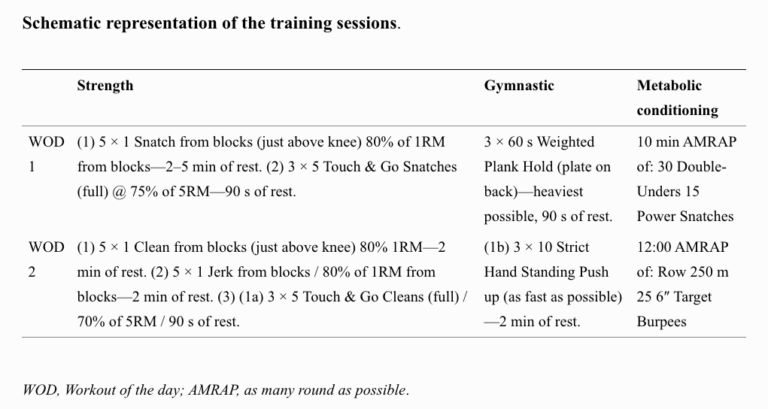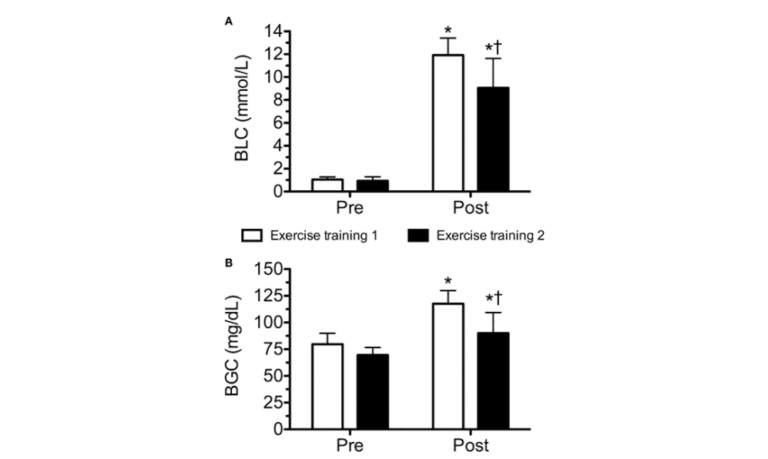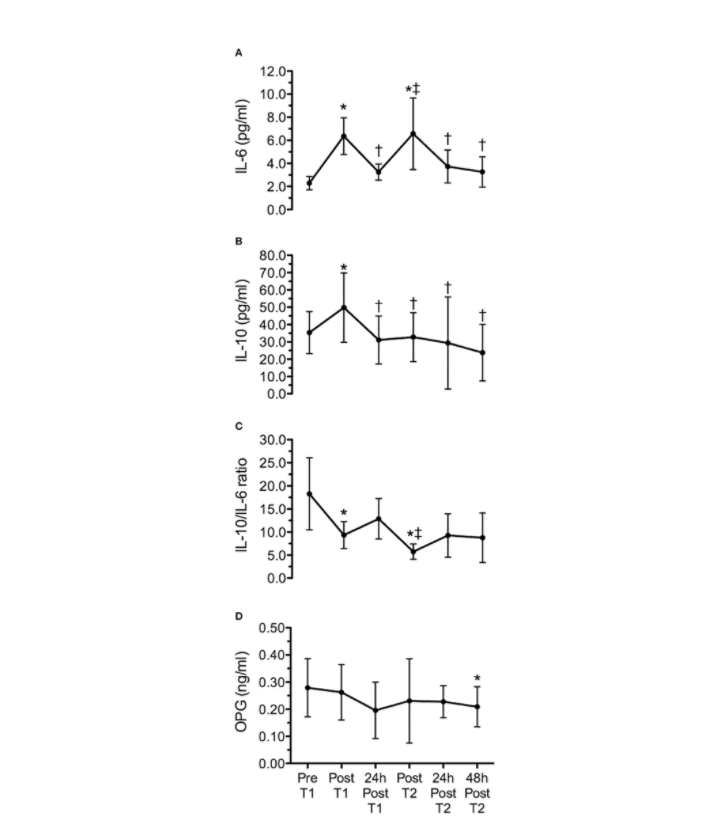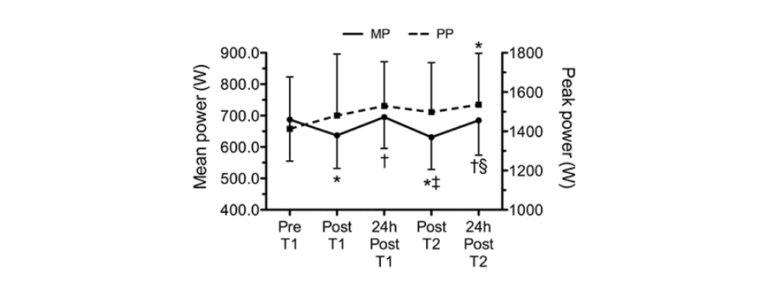Question: Does repeated intense exercise lead to durable impairments in the body’s inflammatory state?
Takeaway: Two consecutive days of CrossFit training led to increased inflammatory cytokine levels immediately after each workout, but these levels were reduced to baseline within 24 hours.
Limited previous research has indicated repeated, high-intensity exercise increases markers of blood oxidative stress and inflammation — including interleukin-6 (IL-6), markers of muscle damage, and markers of oxidative stress — for multiple days after exercise (1). IL-6 increases as much as 100-fold during exercise (2), in part as a direct response to muscular damage and to increase muscular energy supply (3). Previous studies, however, have not tested the direct effect of CrossFit workouts performed on consecutive days.
Nine men who had been doing CrossFit for at least six months (mean age: 26.8) were recruited. Subjects were told not to exercise for 48 hours prior to testing. Each subject completed the two workouts described below at the same time on consecutive days.

Figure 1: Schematic representation of the two workouts. WOD 1 was performed on day 1 and was designed to emphasize Olympic lifting, while WOD 2 was performed on day 2 and was designed to emphasize body-weight movements.
As expected, blood lactate and blood glucose concentrations increased substantially immediately after each workout, with greater increases seen after the first workout than the second.

Figure 2: Changes in blood lactate and blood glucose concentrations immediately after each workout
IL-6 levels increased significantly immediately after each workout but were not significantly different from baseline 24 hours after each workout. Interleukin-10 (IL-10) levels increased significantly only after the first workout and were not significantly different from baseline at any other time point studied.

Figure 3: Changes in levels of inflammatory markers at various times after each workout, compared to baseline
Barbell back squat mean power output (as measured using a linear position transducer) was significantly reduced immediately after each workout but was not significantly different from baseline 24 hours after each workout. Peak power output was unchanged throughout the study apart from a significant increase (compared to baseline) observed 24 hours after the second workout.

Figure 4: Changes in levels of inflammatory markers at various times after each workout, compared to baseline
Taken together, these results indicate two consecutive days of CrossFit workouts induce significant but largely temporary changes in the body’s inflammatory state. IL-10 suppresses macrophage activation (4), so the temporary increase in IL-10 immediately after the first workout may indicate a temporary reduction in immune response. However, this status had returned to baseline within 24 hours of each workout. These results are consistent with previous studies of resistance training and high-intensity exercise, which found significant inflammatory responses immediately after exercise that decreased back to (or even below) baseline within 24 hours (5).
As a final caveat, it is worth noting that the small sample size contributed to significant variance in the observed data, as is reflected in the large error bars across all figures. A larger study may detect small changes in inflammatory state and/or power output, which this trial was unable to detect.
Notes
- Adrenal cortical responses to high-intensity, short rest, resistance exercise in men and women; The effects of high intensity short rest resistance exercise on muscle damage markers in men and women; Acute exercise and oxidative stress: CrossFit(™) vs. treadmill bout
- Physical activity and plasma interleukin-6 in humans–effect of intensity of exercise; Impact of a competitive marathon race on systemic cytokine and neutrophil responses; Increase in IL-6, TNF-α, and MMP-9, but not sICAM-1, concentrations depends on exercise duration
- Exercise-induced increase in serum interleukin-6 in humans is related to muscle damage; The anti-inflammatory effect of exercise
- Interleukin-10 and the interleukin-10 receptor
- Acute effects of resistance training on cytokines and osteoprotegerin in women with metabolic syndrome; Response of bone turnover markers and cytokines to high-intensity low-impact exercise
Comments on Two Consecutive Days of Extreme Conditioning Program Training Affects Pro and Anti-Inflammatory Cytokines and Osteoprotegerin Without Impairments in Muscle Power
Pretty sure that's true with most all modes of training (power wise). What do you think the power output would be 30 days later with the same workouts on the 3on 1 off protocol? Reduced.
More importantly from a health standpoint, with significant inflammation produced after 2 days what do you think it's like after 24 day of 30 High Intensity training (30n 1off?)
It's in a chronic state throughout.
Which is why via plenty data showing this or decades of trial and error, other than CrossFit you'll never see high intensity training in sports or fitness programming more than 12 times in a month. Sometimes less.
Training performance is significantly better, skills and auxiliary capacity's are better developed with the other designated days for them, body maintains higher levels of orthopedic, neural and cellular health.
Tim,
I'm curious about the data you mentioned. Do you have a source for it?
There's a lot of variables that dictate training frequency. When talking about muscles, you often hear of "time under tension" as a measure of stress on the muscle. A more CrossFit-relevant metric would be "time under intensity".
If you were to take the same amount of time under intensity and divide it over 3 workouts per day, I think you'd actually recover better than if you did the same time under intensity in a single workout.
This is a pretty interesting study. It’s become all too common to assume that inflammation is bad. This is not true at all. Inflammatory responses evolved over millions of years to protect and repair our bodies from acute stressors like exercise, injuries and infections.
Inflammation is bad when it becomes chronic and systemic. Unresolved inflammation contributes to a variety of chronic disease states.
What this study shows is that the inflammatory response following CrossFit workouts is temporary and normalizes within 24 hours. This is really good news. These CrossFit athletes were able to mount an effective inflammatory response, resolve it and return to peak performance in a very short time window.
Echoing Peter, further study with a larger, more diverse sample and over a longer time scale would be great to see.
Interesting data. However, 1) there study was too short and did not accurately cover the time frame of cycles that I witness in my box. I don't see the individuals in this age group taking rest days after two sessions. The study should have followed these men for a minimum of a two week cycle. 2) The age group covers the demographic in CrossFit gyms but what about data on older individuals over a longer period. 3) There was no mention of the diet and sleep which needs to be uniform among the participants. 3) I think singular WODS should have been measured and collected before combining elements. 4) There are many confounding factors in this study.
Cheers,
Peter DeLannoy, Ph.D., PHC, NN Advisor
That makes complete sense to me ... And bears out with how we train. The more we train, the less sore we are, and, therefore, our recovery is faster 👍
Two Consecutive Days of CrossFit Affects Inflammation Without Impairing Muscle Power
5